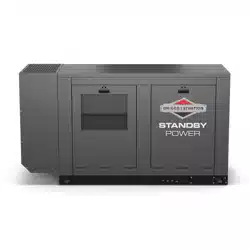Loading ...
Loading ...
Loading ...

15
Type of Fuel to Use
An important consideration affecting the entire
installation is the type of fuel to be supplied. For
proper engine function, use clean, dry fuel, free of
moisture or any particulate material. Using fuels
outside the recommended values may cause
performance problems.
Fuel Pressure
Fuel supply pressure at the generator fuel inlet port (or
vaporizer test port) should be 7 - 11 inch WC (17 - 28
mBar) at full load and with all gas appliances turned
on and operating. Maximum pressure drop from static
(engine not running) to full load is 0.5 inch WC (1.3
mbar). Maximum pressure with engine OFF at no load
is 13.85 inch WC (34.5 mbar). Liquid propane fuel
pressure at generator inlet should be 100-250 psi (690-
1725 kPa)
Power Loss
Engine power will decrease 3% for each 1,000 feet
(300 m) above sea level and 1% for each 10°F (5.6°C)
above 77°F (25°C).
WARNING
Fuel is extremely flammable and explosive,
which could cause burns, fire or explosion resulting in death
or serious injury.
• The generator is equipped with automatic safety “fuel
shut-off” valve(s).
• DO NOT operate the equipment if the “fuel shut-off”
valves are missing or inoperative.
Physical Properties LP Vapor Natural
Gas
Normal Atmospheric State Gas Gas
Boiling Point (°F): -44 -259
Heating Value:
BTU per gallon (Net LHV *)
BTU per gallon (gross **)
BTU per cubic feet (gas)
83,340
91,547
2,500
63,310
1,000
Density *** 36.39 57.75
Weight † 4.24 2.65
* LHV (Low Heat Value) is the more realistic rating.
** Gross heat value does not consider heat lost in the
form of water during combustion.
*** Density is given in “Cubic Feet of Gas per Gallon of
Liquid”.
† Weight is given in “Pounds per Gallon of Liquid”.
Not for
Reproduction
Loading ...
Loading ...
Loading ...
